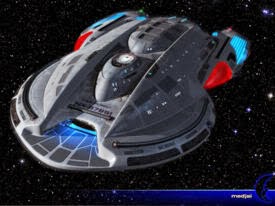Sunbird Class Starfleet Vessel
Category: Frigate
The Sunbird uses the multi-configuration nacelle technology first pioneered on the Intrepid and successfully implemented on other craft, such as the Delta Flyer, the revised warp field geometries allowed the Sunbird to attain high velocities. Unlike those predecessors, the Sunbird nacelles would retract fully not when at impulse, but when entering an atmosphere, at which time it would rely upon its maneuvering thrusters, or when maximizing shield coverage. Its warp core, a cousin of the one used aboard the Intrepid class, could produce sufficient quantities of power to drive the engines. While they were over-sized, they provided a cruising speed comparable to that of an Excalibur. However, its maximum attainable emergency velocity would not have been possible, at least not for more than a few hours, if not for the structural work undertaken to prevent the Sunbird from flying apart. Every aspect of the ship hull was designed for high-velocity travel, allowing it to push further and faster to reach crisis areas more quickly than most other starships.
The Sunbird has holo-emitters throughout the ship, allowing the EMH to function in key and public ares throughout the vessel. The Sunbird tactical systems incorporate some of the latest advances in phaser and torpedo technology insofar as volume and power requirements permit. The ship armament of Type X phaser arrays, while numbering no fewer than 12, provide it with less firepower than the arrays found aboard the Luna, and its torpedo armament is akin to that of the Akira, a design a good 20 years older than the Sunbird, and chosen because of spatial requirements. Its shields, however, are some of the best to be found aboard a Federation starship. While lacking the overall output of capital ships, the Sunbird protective fields can take a punishment almost equal to the damage that can be inflicted upon an Akira, but the primary emphasis in their design was on making them adaptable to inhospitable environments that, on previous missions, were more than capable of rendering otherwise modern Starfleet shielding systems nearly, if not completely, inoperable. It is their flexibility rather than their endurance that is their great strength.
The Sunbird was designed to operate in, and provide aid, across the furthest reaches of the Federation, places where Starfleet vessels were few and far between and the dangers posed by nature and sentient malfeasance were both unpredictable and deadly.


